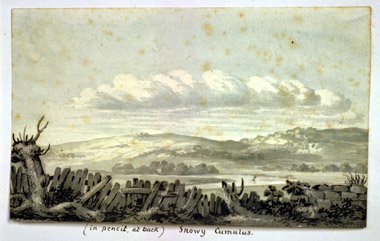
From Luke Howard's Sketch Book


|
Where was experimental physical science at the turn of the 19th century? A listing of the major scientific discoveries of the 17th and 18th centuries shows that many of the principles necessary for understanding the atmosphere had been set forth, even if they were not fully incorporated into the thought processes of the scientific community of the day. For example:
Prior to the year 1800 A.D., approximately, clouds had been thought of as outside the realm of classification and analysis. This was due to their ephemeral character -- coming and going, appearing and disappearing. And yet this point of view was not to persist. One reason was the impact on human thought of Swedish taxonomist, Linnaeus, through his landmark studies of natural history. Linnaeus -- Carl von Linne -- had greatly influenced Howard and this influence resulted in a paper on pollens, read in 1800 before the Linnean Society of London. It seems quite reasonable to assume that young Howard, at that time, had developed a mind-set that was favorably oriented toward classification in the Linnean scheme. One of the curiosities of the growth of science is that new ideas quite frequently emerge independently and at about the same time in different countries. We have an example of this in conjunction with cloud nomenclature. As the story is told in the Preface of the International Cloud Atlas:
What enabled him to do this? Being steeped in Latin as a schoolboy? Initial captivation by the 1783 skies? Having the habit of observing nature with persistence and care? Curiosity as to why it rains? Being utterly convinced that orderly Providence would not make a disorderly sky? It is difficult, if not impossible, to rank these factors according to priority. No doubt, all played some part. We take a closer look at the sequence of events that led to the Essay. We find Luke Howard, returning to London in 1787 as a chemist's apprentice, and twenty years later (1807) the sole owner of a prospering chemical manufacturing laboratory. But while he carried on his business activities and commitments, he continued his vocation of "natural philosopher", with sharp focus on meteorology. As he said in his later years, "meteorology is my real penchant".
An outlet for, and a stimulus to, this side of his life was the Askesian Society ( Askesian derives from a Greek work meaning "philosophical exercise") to which he belonged as a charter member from its 23 March 1796 beginning. Howard had other like-minded friends, some his age and others older, who were interested in expanding their knowledge on all fronts of various subjects. It seems that his close friend, William Allen, was the principal moving agent in starting the small society. Whether or not Allen made the suggestion for the name, we do not know. Howard comments about the society:
The circumstances that led to the Essay were probably along the following lines. Howard's consuming interest in atmospheric phenomena had been well established. He had already given one paper to the Askesians on Causes of Rain (23 February 1802) so he was deeply involved in thinking about the total problem at times when his attention was not taken with the problems of the "chemical works". The setting: the home of Wm Allen in Plough Court, London on 16 December 1802 (evidence of the precise place and date strangely is missing from the Askesian Society minutes, so this is a probable conclusion). Howard's subject: "Essay on Modifications of Clouds" (in today's English a better word is Classifications). The full essay can be found in Rees' Cyclopaedia in Tilloch's Philosophical Magazine vols. xvi, xvii. For our purposes the key idea set forth by Howard is that it is possible to identify, from within the complexity of changing skies, a number of simple categories. Howard's "genius" lay in the use of Latin names, thus transcending national boundaries. The categories are:
In his paper, Howard presents a lengthy description of, and rationale for, these various forms of cloud. With some minor adjustments in nomenclature, these are the categories and names used by meteorologists of all countries, 200 years later! This is a remarkable testimony to Howard's perceptive insight into cloud forms, the primary observable phenomena of meteorology. |
||||||||||||||||||||||||||||||||||||||||||||||||||||||||||||||||||||||||||||||||

Luke Howard -- "The Godfather
of Clouds"
Luke Howard -- Cloudman Foreword | Essay
#1 Background Setting
Essay #2 1783 -- A Year to Remember | Essay #3 1802 -- Year of Significance

Cloud History Topics
Luke Howard -- "The Godfather of Clouds | Wilson A. Bentley -- "The Snowflake Man"
![]()
![]()
All Rights © Copyright John A. Day, 1998 - 2007
Site Design by DoubleRich Design
Last updated on: